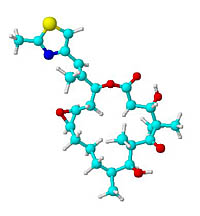Racing for anticancer drugs
By David Bradley
The race to build a novel group of natural products is over between
three independent groups of chemists who spent much of last year*
hunting for synthetic routes to the epothilones.
 The epothilones, it is reckoned, could usurp the anticancer drug Taxol (and
its relative Taxotere), found in parts of several species of yew tree, in the
next few years. Various in vitro tests on the two main epothilones A and
B have shown that they are even more powerful than Taxol. For instance, they
work more effectively against the standard US National Cancer Institute cancer
cell lines for breast and colon tumours.
The epothilones, it is reckoned, could usurp the anticancer drug Taxol (and
its relative Taxotere), found in parts of several species of yew tree, in the
next few years. Various in vitro tests on the two main epothilones A and
B have shown that they are even more powerful than Taxol. For instance, they
work more effectively against the standard US National Cancer Institute cancer
cell lines for breast and colon tumours.
Gerhard Höfle of the National Biotechnology Research Institute in
Braunschweig, Germany, pulled the epothilones from a pungent myxobacterial brew
of Sorangium some time in the late 1980s and found that epothilone A had
powerful effects on runaway cell division; in the test-tube at least. "In in
vitro tests epothilone is 20-50 times more potent than Taxol and acts
faster," he says. "preliminary in vivo results indicate comparable
activity." Further research showed that the epothilones work pretty much by the
same mechanism as the more chemically complex Taxol structure. Taxol blocks
disassembly of the microtubules that are involved in cell division. Anything
that does a similar job would be an immediate potential anticancer agent because
it block the runaway cell division of the disease.
Importantly, epothilones have two properties that might make them even better
than Taxol in the fight against cancer. They are slightly soluble in water while
the insolubility of Taxol is notorious. This should make drug formulation far
easier. The second property is that the epothilones are effective against some
cancer cells that have developed resistance to common chemotherapy and something
that is of growing concern to Taxol researchers.
In early 1996, Höfle and his team figured out the exact structure of
epothilone A using X-ray crystallography (Angewandte Chemie, 1996, vol 35, p
1567). This switched on the green light for chemists to tackle the total
synthesis of the natural product.
The official winner was organic chemist Samuel Danishefsky of the
Sloan-Kettering Institute for Cancer Research in New York and his colleagues at
Columbia University (Angewandte Chemie, vol 35, p 2801) with Kyriacos C "KC"
Nicolaou of the Scripps Research Institute, La Jolla and the University of
California, San Diego a very close second (Angewandte first issue of 1997) -
Nicolaou and his team were winners in the race to synthesise Taxol itself in
1994.
Dieter Schinzer, of the Technical University of Braunshweig, at the time of
writing, has just taken the bronze with his team's version of the synthetic
epothilones now in press with Angewandte Chemie.
The researchers' various synthetic routes are a lot shorter than those needed
for Taxol - simply because epothilones are a lot less complicated than Taxol.
Danishefsky's synthesis is based on building a basic linear skeleton from simple
starting materials and then using a so-called macroaldolisation condensation to
tie the two ends together in a ring.
Nicolaou built three epothilone fragments and then pieced them together like
a jigsaw. The routes should allow a library of analogues to be created and any
one of these analogues could be a potential lead with improved chemical and
clinical properties over current drugs. Nicolaou is confident that "A practical
[production scale] synthesis for epothilone A, or an analogue of it, is a very
real possibility."
"If epothilone can displace Taxol in the future is an open question,"
cautions Höfle, "and depends on its pharmacological properties and many other
factors," he says. Clinical trials will be underway within three or four years
and then its advantages or otherwise will become apparent.
*This article was written in
1997 for Issue 3 of the new Elemental Discoveries website, it persists to this
day as one of the most popular articles in the archive, this month, with an
average of ten readers every day. This compares with overall site visitor rates
of up to 4500 per day! So, it doesn't get a huge share, but given that it's
almost ten years old, that can't be bad. It comes in at #3 when one searches for
the word "epothilone" alone in Google, which might explain its continued
popularity. I will at some point write an update, so watch the RSS newsfeed for
the latest
news on epothilone.
On May 17th, 2005, Schering AG released information about its
synthetic analog of the
epothilone
anticancer drug - ZK-EPO.
 The epothilones, it is reckoned, could usurp the anticancer drug Taxol (and
its relative Taxotere), found in parts of several species of yew tree, in the
next few years. Various in vitro tests on the two main epothilones A and
B have shown that they are even more powerful than Taxol. For instance, they
work more effectively against the standard US National Cancer Institute cancer
cell lines for breast and colon tumours.
The epothilones, it is reckoned, could usurp the anticancer drug Taxol (and
its relative Taxotere), found in parts of several species of yew tree, in the
next few years. Various in vitro tests on the two main epothilones A and
B have shown that they are even more powerful than Taxol. For instance, they
work more effectively against the standard US National Cancer Institute cancer
cell lines for breast and colon tumours.